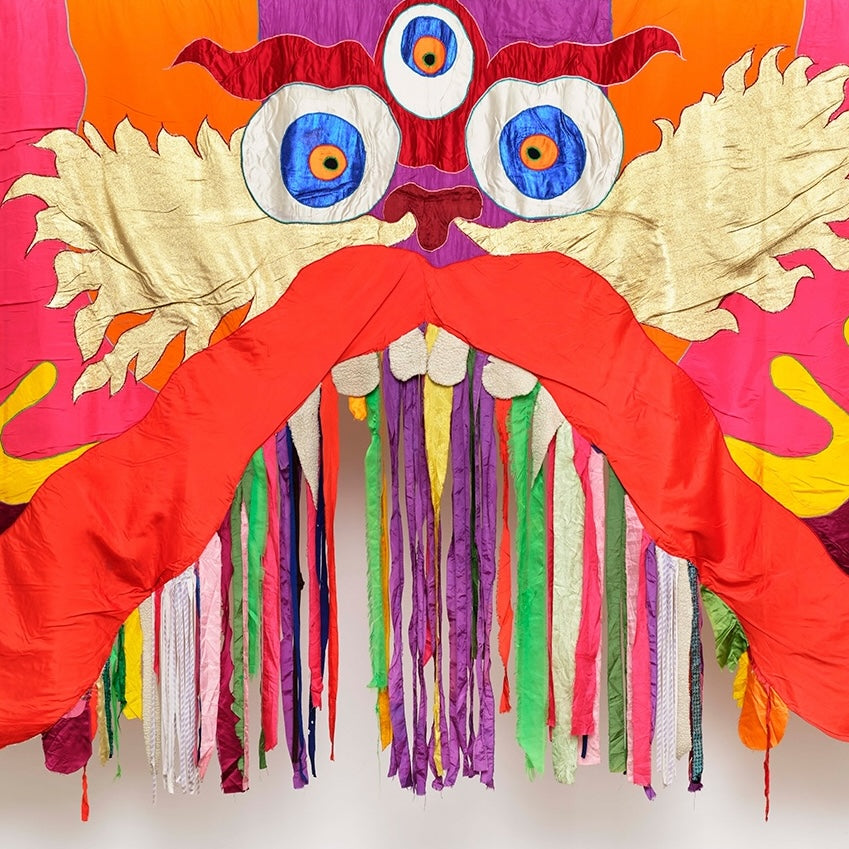
The Living Temple: The World of Moki Cherry
Now on view at the Fabric Workshop and Museum in Philadelphia, The Living Temple: The World of Moki Cherry presents the largest exhibition of the Swedish artist's work ever staged in the United States, and it unfurls like one of her expansive appliqué works: vivid, layered, and brimming with life.

Moki and Neneh Cherry in their home in Gamla Stan, Stockholm, 1967. Photo: Sven Åsberg. Courtesy of the Estate of Moki Cherry.
Born Monica Karlsson in Norbotten, Moki Cherry (1943-2009), built a career that dissolved the boundaries between art, family, and everyday ritual. Her guiding mantra—"home as stage, stage as home"—infused every textile, painting, and costume she made. These were not static works, destined to hang untouched in galleries. They were backdrops to music, banners of protest and celebration, clothes for musicians, and wall hangings that transformed ordinary domestic rooms into radiant spaces of performance.
Visitors will encounter her large, hand-stitched works, once pinned across schoolhouse walls and loft apartments, now vibrating with the same energy that framed concerts, plays, and family gatherings. Moving through the galleries offers a glimpse of how fabric functioned for Moki as both shelter and stage-light, simultaneously practical and transcendent.
 Moki Cherry, Organic Music (Don Cherry, Nana Vasconcelos, Moki, G. Pramaggiore) (Handmade Tour poster) , 1975. Textile appliqué (silk, cotton, mixed fabrics). 47.24 x 38.58 inches. Photo: Anders Sune Berg, courtesy Galleri Nicolai Wallner.
Moki Cherry, Organic Music (Don Cherry, Nana Vasconcelos, Moki, G. Pramaggiore) (Handmade Tour poster) , 1975. Textile appliqué (silk, cotton, mixed fabrics). 47.24 x 38.58 inches. Photo: Anders Sune Berg, courtesy Galleri Nicolai Wallner.
Much of this vision was shaped by her life with jazz musician Don Cherry and their children. Their homes (in Sweden, New York, and wherever their nomadic path led) were never private enclosures but open temples of art. The Cherrys bought an old schoolhouse in Tågarp, Sweden, that became both a family home and a creative hub. Here, children rehearsed theatre productions, musicians drifted in and out, and Moki stitched vast wall hangings while meals were prepared and instruments tuned. For her, motherhood was not separate from artistry; it was the soil in which her practice took root.
 Moki Cherry, D.C (portrait of Don) , 1981. Textile appliqué tapestry (silk, cotton, mixed fabrics). 76.77 x 33.46 inches. Installation view: Moki Cherry: Here and Now, ICA London . Photo credit: Rob Harris, ICA London, 2023.
Moki Cherry, D.C (portrait of Don) , 1981. Textile appliqué tapestry (silk, cotton, mixed fabrics). 76.77 x 33.46 inches. Installation view: Moki Cherry: Here and Now, ICA London . Photo credit: Rob Harris, ICA London, 2023.
The Living Temple invites audiences to experience Moki's whole world through her work. Concert posters hang alongside tapestries; film footage plays beside ceramic vessels and appliqué banners. What emerges is a portrait of an artist who insisted that creativity could not be contained by walls or disciplines. As co-curator Mark Christman, Executive & Artistic Director of Ars Nova Workshop, explains: "Moki's moveable art transformed otherwise unremarkable spaces into the setting for the 'happening'-like concerts she and Don organised." He notes that visitors will enter into this artistic immersion—"not only to see Moki's creative eye but to understand the role that the works played in creating a total experience."
 Moki Cherry, Don Cherry’s Top , 1969. Mixed fabrics. 27.56 x 23.62 inches. Installation view: Corbett vs. Dempsey, Moki Cherry Communicate, How?: Paintings and Tapestries, 1967–1980, 2021. Photo credit: Tom Van Eynde.
Moki Cherry, Don Cherry’s Top , 1969. Mixed fabrics. 27.56 x 23.62 inches. Installation view: Corbett vs. Dempsey, Moki Cherry Communicate, How?: Paintings and Tapestries, 1967–1980, 2021. Photo credit: Tom Van Eynde.
The exhibition also speaks to Moki's deep engagement with global craft traditions. She drew inspiration from Swedish folk motifs, Indian art, African textiles, Tibetan mandalas, and Indigenous forms of making, blending them into works that were both rooted and radically open. In doing so, she anticipated the contemporary language of hybridity, ecology, and transcultural exchange.
In celebrating Moki Cherry, the Fabric Workshop and Museum illuminates an art practice that was as hospitable as it was visionary: a life where cloth became stage curtain, blanket, and banner of belief. The home was always open—part classroom, part concert hall, part sanctuary. A living temple, stitched together by hand and heart.
-
Further Information:
The Living Temple: The World of Moki Cherry is on now until April 12, 2026 at the Fabric Workshop and Museum in Philadelphia
-
-
Image Credits:
Lead: Moki Cherry, Title Unknown (Dragon) (Detail), 1975. Textile appliqué tapestry (silk, cotton, mixed fabrics). 78.75 x 137.75 inches. Photo credit: Anders Sune Berg, Galleri Nicolai Wallner.
All other images as credited in photo captions.
